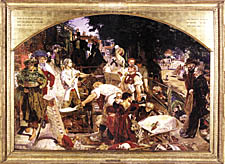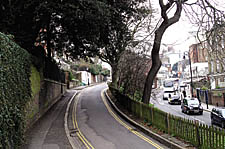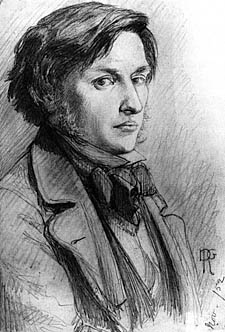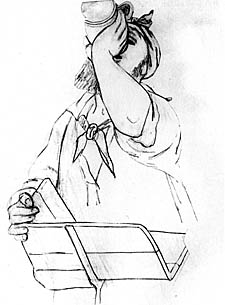|
|
 |
| |

Work by Ford Madox Brown

The Mount today: Brown constructed a special shelter using
a market traders barrow to keep the sun off as he painted
from this spot

Brown in 1852 by Dante Gabriel Rossetti

A navvy draining a beer, 1855: Brown drew
in pencil before transferring images to canvas |
Idealised and idolised: The navvies who built London
The paintings of Ford Madox Brown can be seen as visual versions of Dickens novels, writes Dan Carrier
Work: Ford Madox Brown’s Painting and Victorian Life
by John A Walker
Francis Boutle Publishers, £20
THE pregnancy was not planned, but was hardly a surprise: the
artist Ford Madox Brown had fallen in love with a young model
called Emma Hill and they were sleeping together.
He was fearful of what his straight-laced Victorian contemporaries
would make of his affair with a young, provincial woman who
hailed from a different social strata. His answer was to leave
his Bloomsbury address and make his way north to Hampstead,
where he believed he could live happily with his lover in relative
obscurity.
Brown found lodgings at number 33, Hampstead High Street and
Emma gave birth to a healthy baby girl Catherine on November
11 1850. Brown funded a series of addresses throughout Hampstead
for his lover and their child, which allowed time for her to
become educated and for Brown to win approval from Emma’s
mother.
And this enforced move prompted the creation of one of the artist’s
best-known pictures, which has become a subject of new book
by historian John Walker.
Entitled Work, it is a painting that encapsulates Brown’s
political ideology and tells the story of Victorian attitudes
towards class and occupation.
Mr Walker has taken a picture as his starting point, and in
this revealing and accessible book looks beyond the canvas to
bring together a fascinating history behind the scene.
Brown had studied art through out Europe and when he returned
to England he started working as an art tutor at the Working
Men’s College in Crowndale Road.
It was from here he set his mind to recording the Victorian
working class in an urban environment.
It was while he was living at 33, the High Street that Brown
became inspired by roadworks. Hampstead, popular because of
the areas natural springs, meant outside Brown’s home were
pipes being laid to take water elsewhere.
Walker’s book explains this led to Brown deciding to focus
his work on a particular group of workers he wanted to celebrate,
a group that were at the front of the public’s imagination
for their part in forging the workshop of the world: the navvy.
Britain’s canals and railways, the rapid expansion of which
in the period was the driving force behind the massive industrial
leaps inspired by Isambard Kingdom Brunel and Joseph Bazalgette,
had all been dug by the muscle power of the navvy. They were
feted: as Walker explains, when they were sent to the Crimea
to build a railway during the conflict with Russia, the navvies
returned as heroes.
The book reveals this was another reason he chose The Mount:
“Brown’s choice of Hampstead for Work was not arbitrary:
the village was becoming another suburb of London but was still
near farmland.”
The author says this means there was a range of classes Brown
could paint – labourers, the well-heeled, street traders
– a cross section of Victorian society. And Work, according
to Mr Walker, is a visual version of a Charles Dickens novel.
He writes: “Like so many Victorian pictures, it seems to
some modern viewers to be overcrowded with figures, animals
and finicky detail…like one of Dickens’ novels, it
takes days to read…” |
|
 |
|




